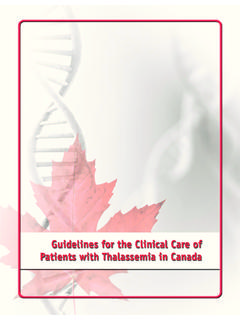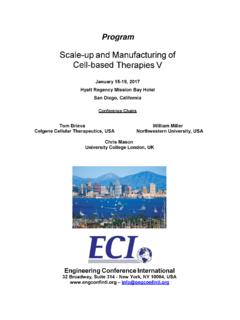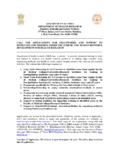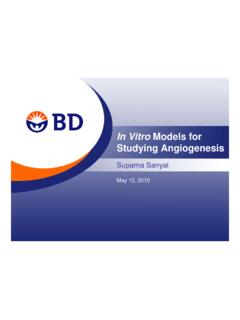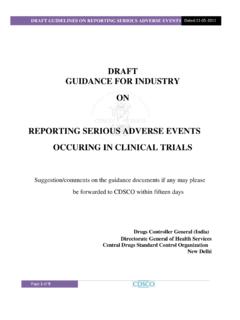Transcription of Recommendations for the evaluation of animal cell …
1 ENGLISH ONLY FINAL Recommendations for the evaluation of animal cell cultures as substrates for the manufacture of biological medicinal products and for the characterization of cell banks Proposed replacement of TRS 878, Annex 1 World Health Organization 2010 All rights reserved. Publications of the World Health Organization can be obtained from WHO Press, World Health Organization, 20 Avenue Appia, 1211 Geneva 27, Switzerland (tel.: +41 22 791 3264; fax: +41 22 791 4857; e-mail: Requests for permission to reproduce or translate WHO publications whether for sale or for noncommercial distribution should be addressed to WHO Press, at the above address (fax: +41 22 791 4806; e-mail: The designations employed and the presentation of the material in this publication do not imply the expression of any opinion whatsoever on the part of the World Health Organization concerning the legal status of any country, territory, city or area or of its authorities, or concerning the delimitation of its frontiers or boundaries.))
2 Dotted lines on maps represent approximate border lines for which there may not yet be full agreement. The mention of specific companies or of certain manufacturers products does not imply that they are endorsed or recommended by the World Health Organization in preference to others of a similar nature that are not mentioned. Errors and omissions excepted, the names of proprietary products are distinguished by initial capital letters. All reasonable precautions have been taken by the World Health Organization to verify the information contained in this publication. However, the published material is being distributed without warranty of any kind, either expressed or implied.
3 The responsibility for the interpretation and use of the material lies with the reader. In no event shall the World Health Organization be liable for damages arising from its use. The named authors alone are responsible for the views expressed in this publication. Adopted by the 61st meeting of the WHO Expert Committee on Biological Standardization, 18 to 22 October 2010. A definitive version of this document, which will differ from this version in editorial but not scientific details, will be published in the WHO Technical Report Series. Page 2 Recommendations published by the WHO are intended to be scientific and advisory. Each of the following sections constitutes guidance for national regulatory authorities (NRAs) and for manufacturers of biological products.
4 If a NRA so desires, these Recommendations may be adopted as definitive national requirements, or modifications may be justified and made by the NRA. It is recommended that modifications to these Recommendations be made only on condition that modifications ensure that the biological product is at least as safe and efficacious as that prepared in accordance with the Recommendations set out below. The parts of each section printed in small type are comments for additional guidance intended for manufacturers and NRAs, which may benefit from those details. Table of contents 1. 2. Historical overview ..5 3. 4. 5. General considerations.
5 13 Types of animal cell substrates Primary cell cultures ..13 Diploid cell Continuous cell lines ..15 Stem cell lines ..16 Potential risks and risk mitigation associated with biologicals produced In animal cell Viruses and other transmissible agents ..17 Cellular DNA ..19 Cellular RNA ..21 Growth-promoting proteins ..22 Part A. General Recommendations applicable to all types of cell culture Good manufacturing practices ..23 Principles of good cell culture Understanding the cells and the culture system ..23 Manipulation of cell cultures ..24 Training and Cell line development and cloning ..25 Special considerations for neural cell Selection of source materials.
6 27 Page 3 Serum and other bovine-derived materials used in cell culture media ..28 Trypsin and other porcine-derived materials used for preparing cell culture ..30 Medium supplements and general cell culture reagents derived from other sources used for preparing cell cultures ..31 Certifications of cell banks by the manufacturer ..32 Cell line Certification of PCCs ..32 Certifications of DCLS, CCLs, and SCLs ..33 Cryopreservation and cell banking ..33 Cryopreservation ..33 Cell banking ..34 WHO reference cell banks ..35 Part B. Recommendations for the characterization of cell banks of animal cell substrates ..37 General considerations.
7 37 Identity ..39 Stability ..40 Sterility ..42 Viability ..42 Growth characteristics ..42 Homogeneity ..43 Tumourigenicity ..43 Oncogenicity ..48 Cytogenetics ..50 Microbial agents ..51 General considerations ..51 Bacteria, fungi, mollicutes and mycobacteria ..65 Transmissible Spongiform Encephalopathies ..67 Summary of tests for the evaluation and characterization of animal cell substrates ..69 Cell seed ..70 Master Cell seed (MCB) and Working Cell Bank (WCB) ..70 Acknowledgements ..73 References ..74 Page 4 Appendix Tests for bovine viruses in serum used to produce cell.
8 82 Appendix Tumourigenicity protocol using athymic nude mice to assess mammalian 86 Appendix Oncogenicity protocol for the evaluation of DNA and cell Abbreviations .. 93 Page 5 1. Introduction Cell substrates are cells used to manufacture a biological product. It is well established that cell substrates themselves and events linked to cell growth can affect the characteristics and safety of the resultant biological products. Therefore, a thorough understanding of the characteristics of the cell substrate is essential in order to identify points of concern and to develop a quality control system that addresses those points.
9 Recent advances in the use and quality control of new animal cell substrates, particularly continuous cell lines (CCLs) and insect cells , led to the conclusion that an update of the current WHO Requirements (TRS 878) [ 1] should be prepared. In order to facilitate the resolution of regulatory / scientific issues related to the use of animal cell cultures, including human, as substrates for the production of biological products, WHO initiated this revision of its Requirements on cell substrates by establishing a Study Group (SG). animal cells refer to cells derived from organisms classified in the animal kingdom. This document is the result of the SG effort, including wide consultations with individuals and organizations with expertise in this area.
10 After receiving comments from this consultative process, as well as from invited reviewers, further revision of the draft Recommendations was undertaken and presented to the ECBS in 2010. During the development of this document, guidances on this topic issued by other relevant organizations were considered. Effort was made to be compatible with the existing guidances, whenever possible. These Recommendations provide guidance to National Regulatory Authorities (NRAs), National Control Laboratories (NCLs) and manufacturers on basic principles and, in some cases, on detailed procedures that are appropriate to consider in the characterization of animal cells that are proposed for use in the manufacture of biological products.










